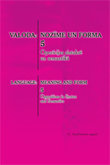Ja un jā, ne un nē funkcijas
The functions of ja ‘if' and jā ‘yes’, ne ‘not’ and nē ‘no’
Author(s): Evelīna ZilgalveSubject(s): Language and Literature Studies, Theoretical Linguistics, Baltic Languages
Published by: Latvijas Universitātes Akadēmiskais apgāds
Keywords: diskursa iezīmētāji; apgalvojums; noliegums; polaritāte; disjunkcija; runātāja maiņa;
Summary/Abstract: There is a little observed issue in Latvian linguistics from the aspect of oppositions in this paper: the different and common functions of jā and nē, ne and nē, ja and ne are analyzed.Assertion particle jā and negation particle nē are often used as discourse markers in the same functions. There are four common functions stated: assertion, concretization, generalization, substation of the predicate.Ne and nē are both related to negation, and nē is often used in the place of ne which is considered wrong from the aspect of language norm. However, this use is due to the polarity – nē is opposed to the whole situation mentioned before, e. g. Ja tas otrs to ievēros, saskatīs, saklausīs, sapratīs – tad jūtas ir abpusējas. Ja nē – tad šis cilvēks nav uz viena viļņa ar jums. ’If the other person notices, discerns, hears and understands it – then the feelings are mutual. If no – then this person is not on the same wavelength with you.’ The word group vai nē used after an affirmative verb is used in disjunction, analogically as in the use of jā vai nē, e. g. Ar laiku bērns apzinās, vai vecāki viņu mīl vai nē, vai viņš ir saviem vecākiem vajadzīgs, nozīmīgs. ‘By the time the child understands if parents love him or no, if he is necessary, important to his parents.’ So a choice from two given possibilities a or b has to be made.Ja and ne are used in questions when the speaker wants the addressee to agree to what the speaker has said, e. g. Es saprotu, ka @CVK_zinas provizoriskos balsošanas rezultātus strukturētā formātā nemaz nepiedāvā, ja? Oh well.. ‘I understand that @CVK_zinas do not offer the preliminary voting results in a structured format, right? Oh well..’ In these cases ja and ne are used in the functions of turn-final discourse markers. Ja in this use should be considered as a particle like ne.There are seven functions stated in this paper, there are at least two of the words ja, jā, ne and nē used in each of them.
Journal: Valoda: nozīme un forma
- Issue Year: 2014
- Issue No: 5
- Page Range: 157-171
- Page Count: 15
- Language: Latvian

